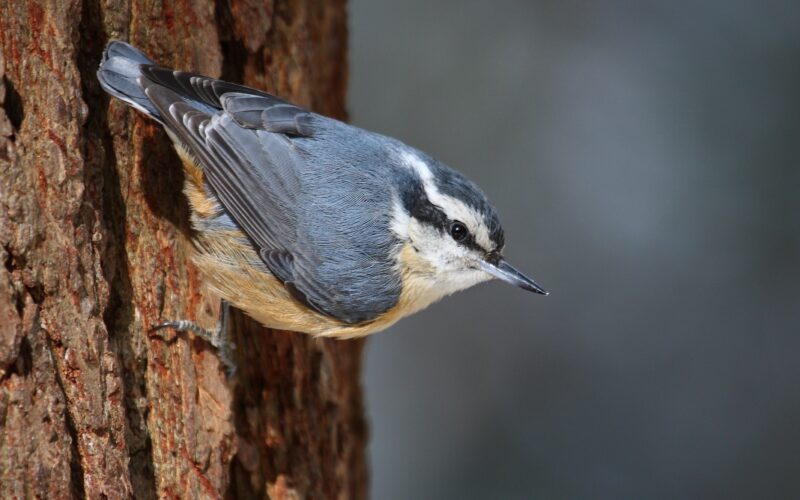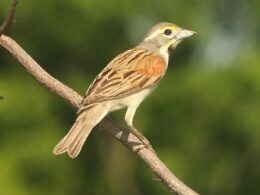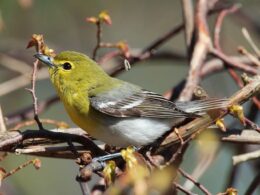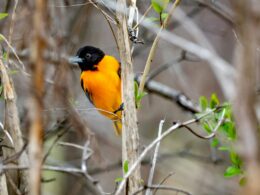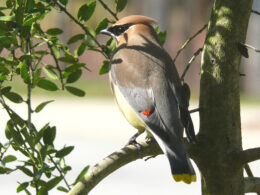Last Updated on January 20, 2024 by Greg Gillson
This article is for you if you are planning on setting up a bird feeder this winter and would like some help.
Are you looking for some new ideas to attract more birds to your feeder?
Are you wondering what birds you can expect at your feeder, and what they look like?
Then this article is for you!
This article tells why and how to set up a bird feeder in Minnesota in the winter. I’ll also show you photos of the common feeder birds in Minnesota that you can look for at your own backyard feeder! I will give brief identification tips. I will tell you what foods and what type of feeders attract each species.
Winters in Minnesota are often bitterly cold and snowy–I know, I spent my first 7 years there! Some of my first memories are stumbling out to the ice fishing house on the frozen lake. Snow is the major form of precipitation in winter in Minnesota.
I remember stringing popcorn on thread for the cardinals as a child. I’ve got better suggestions for bird food, below.
Birds that remain for the winters will appreciate your bird feeders!

Why feed winter birds in Minnesota?
Winters are harsh in Minnesota.
While the birds that do remain for the winter can usually survive without help from humans, they may often thrive when there are well-stocked backyard bird feeders.
Especially birds in their first year may need help to find food. Feeders provide a source of food when they may not be able to so easily find natural food.
Another reason to feed birds in winter in Minnesota is to bring nature into your backyard.
Watching birds at your feeder is an easy and fun way to get closer to nature–especially during those long cold Minnesota winters. Bird watching and bird feeding can bring peace of mind during the winter season when some people experience some mood problems with the shorter daylight hours.
When your neighbors notice your bird feeders, it may be a conversation starter to help you build friendly relationships with them.
During the school break in winter a bird feeder can be a way to get children involved in out door activities–away from digital screens and looking out the windows!
And a bird feeder can be an excellent way to bond with the grandchildren.
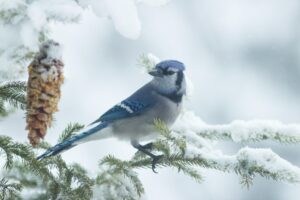
What birds come to feeders in winter in Minnesota?
You may be surprised at the number and variety of birds that come to your bird feeders in winter. It’s true; not all birds leave the snowy lands in winter.
There are some northern birds that move south to Minnesota in winter. However, it is primarily year-round residents that visit bird feeders in winter in Minnesota.
Learn the common dozen or so birds that visit feeders in winter, and you’ll quickly recognize different visitors when they come through in spring.
You don’t have to learn the names of the birds that come to your feeders. You can enjoy feeding birds, even if you don’t try to name them.
However, learning the names of the birds will lead you to an enjoyable year-round activity. Wherever you go in this world, there are birds. Lot’s of birds. Different birds in every location and in each different season. Watching them is a wonderful and relaxing past time.
If you are interested, I have written a companion article, describing the birds you are most likely to see in your backyard in Minnesota throughout the year. I’ll link to it at the end of this article.
So here are the winter birds in Minnesota that you are most likely to see at your bird feeder.
Black-capped Chickadee
This bird is a small active acrobatic ball off fluff.
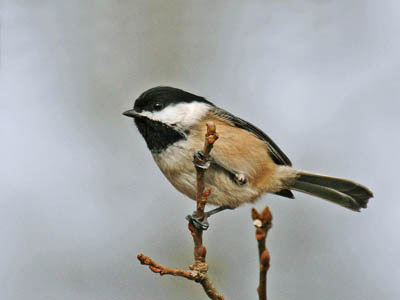 |
| Black-capped Chickadee. Greg Gillson. |
This bird is resident from Alaska and across Canada to the northern half of the United States.
Black-capped Chickadees are year-round residents throughout Minnesota.
The white face is bordered by black crown and bib. Upper parts are gray, under parts buff.
Black-capped Chickadees love black oil sunflower seeds from hopper and tube feeders.
Downy Woodpecker
This small woodpecker is widespread in North America and fairly common at bird feeders in winter.
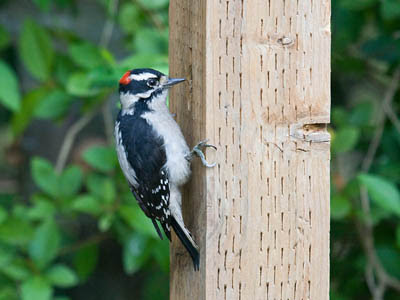 |
| Downy Woodpecker. Greg Gillson. |
Year-round residents from Alaska and across Canada south through the United States, but absent from the Desert Southwest.
Downy Woodpeckers are year-round residents throughout Minnesota.
These are less than 7 inches long, bill tip to tail tip. They have a black and white striped head, white back, and black wings with white spots.
Downy Woodpeckers love suet from suet feeders. They also eat hulled sunflower seeds.
White-breasted Nuthatch
Nuthatches are active birds that crawl around branches and even head-first down tree trunks!
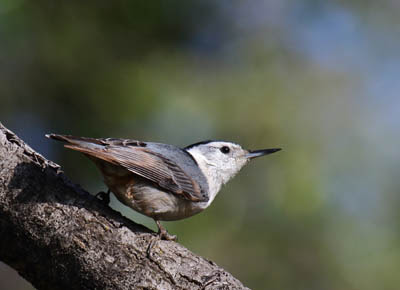 |
| White-breasted Nuthatch. Greg Gillson. |
These are widespread year-round birds across southern Canada and much of the United States. They avoid grasslands and deserts.
White-breasted Nuthatches are year-round residents throughout Minnesota.
These are small chunk birds with large heads with long pointed bill and very short tails. These are gray above with black hind neck and crown. The face and under parts are white. They have a bit of rusty coloration on the flanks.
White-breasted Nuthatches eat black oil sunflower seeds from tube and hopper feeders and are fond of peanuts and suet, too.
Blue Jay
These are well-known birds, displayed in advertising and sports teams.
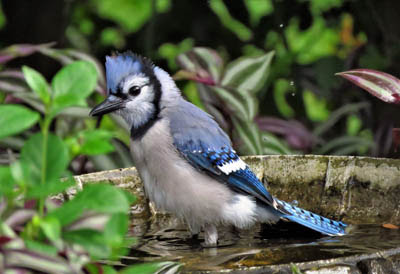 |
| Blue Jay. Skeeze from Pixabay. |
They live year-round in deciduous woods with oaks or nuts through most of the United States east of the Rocky Mountains. In summer they also migrate north well into Canada.
Blue Jays are year-round residents throughout Minnesota.
These are blue above, white below and on the face, with a black necklace across the throat wrapping behind the head. The blue crest is a distinguishing mark.
Blue Jays eat sunflower seeds. They love peanuts, too. They use hopper and platform feeders.
Hairy Woodpecker
These are slightly bigger versions of the Downy Woodpeckers.
 |
| Hairy Woodpecker. Greg Gillson. |
Found from Alaska, across Canada, and south through most of the United States where there are big old trees.
Hairy Woodpeckers are year-round residents throughout Minnesota.
Black wings and tail. White back and under parts. White stripes on face. Male with red spot on back of head. Bigger bill than Downy Woodpecker, otherwise look alike, but don’t use same kind of trees.
Hairy Woodpeckers will visit feeders in winter for suet and nuts.
Dark-eyed Junco
These “snow birds” flock to your feeders in winter.
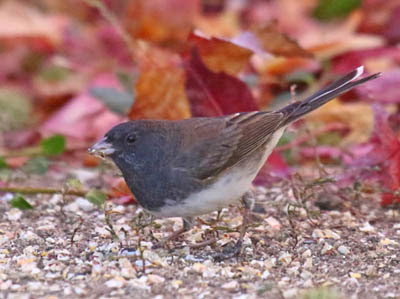 |
| Dark-eyed (Slate-colored) Junco. Greg Gillson. |
Breed in conifer and mixed woods across Canada and Alaska in summer, then migrate into most of the United States in winter. They are also resident in mountains of the West and Northeast.
Dark-eyed Juncos winter residents throughout Minnesota, year-round residents in northeastern Minnesota.
The form in the East are small slate-gray birds with white belly and flashing white outer tail feathers. Females are browner. In the West, birds have black heads, brown backs, and pink sides.
Dark-eyed Juncos eat small seeds such as white proso millet on the ground or from low platform feeders.
Northern Cardinal
These are well-known birds due to their bright red coloration, fairly large size, and perky crest.
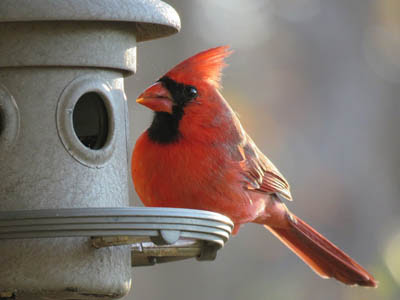 |
| Northern Cardinal. GeorgeB2 from Pixabay. |
These are year-round residents throughout the East and South.
Northern Cardinals are year-round residents in the southern half of Minnesota.
Larger than sparrows, but smaller than robins. Males are bright red, females brown. They have thick orange bills, black chin and throat, and obvious crests.
Northern Cardinals eat larger seeds, including sunflower seeds and safflower seeds from hopper and platform feeders, but often feed on the ground.
Red-bellied Woodpecker
These woodpeckers are fairly common at bird feeders in the East, especially where there are larger hardwood trees.
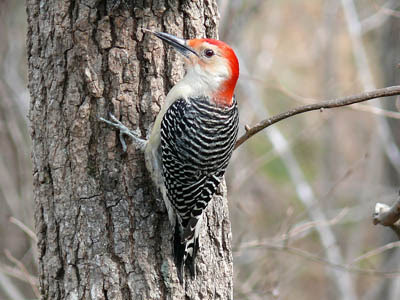 |
| Red-bellied Woodpecker. Skeeze from Pixabay. |
These birds live year-round in the United States east of the Rocky Mountains and Great Plains.
Red-bellied Woodpeckers year-round residents in the southern half of Minnesota.
These birds cling to tree trunks. They have finely barred black-and-white backs. The head and under parts are rather pale gray. Red feathers on the back of the neck reach the bill on males.
Red-bellied Woodpeckers love peanuts from platform feeders. They also eat sunflower seeds and suet.
House Sparrow
These are common city birds in noisy messy flocks.
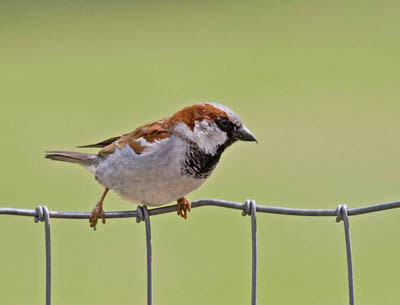 |
| House Sparrow. Greg Gillson. |
Found throughout much of Canada and the United States, wherever there are people and towns.
House Sparrows are year-round residents throughout Minnesota.
Small squatty flat-headed sparrows. Females are rather brown and tan with a pale broad eyebrow, and plain breast without streaking. Males are more chestnut brown above with white wing bars, gray below, with gray crown and black chin, more extensive in summer.
House Sparrows eat a wide variety of small seeds and human food scraps from hopper and platform feeders, and also the ground.
American Goldfinch
This bright yellow-and-black bird is a favorite summer bird. However, many people don’t recognize these birds at their feeders in their dull brown winter plumage.
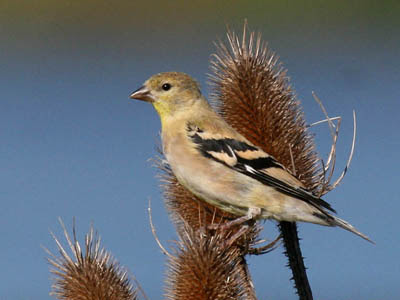 |
| American Goldfinch. Greg Gillson. |
Year-round residents across the northern half of the United States. In summer birds breed north well into Canada. In winter they move south throughout most of the U.S.
American Goldfinches are summer residents throughout Minnesota, year-round residents in southern and southeastern Minnesota.
These are tiny birds with short forked black tails. Wings are black. Winter birds are dull brownish. In summer females are green while males are brilliant lemon yellow with black cap.
American Goldfinches eat black oil sunflower seeds from tube feeders. They love Niger seed from thistle feeders.
Red-breasted Nuthatch
These little birds crawl over the bark of tree limbs and trunks–even upside down!
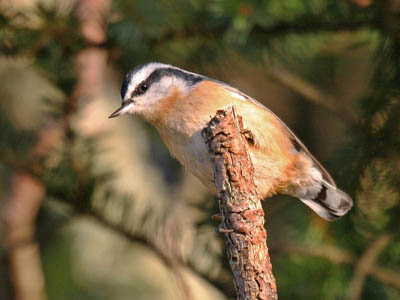 |
| Red-breasted Nuthatch. Greg Gillson. |
This species of nuthatch loves conifer trees. They are found from Alaska and across Canada. They are found in the mountains of the northern and western United States, irregularly in winter being found throughout all of the US.
Red-breasted Nuthatches are winter residents throughout Minnesota, year-round residents in northeastern Minnesota.
These are tiny birds with a stubby tail.
Birds are bluish-gray above and delicately pinkish-orange below. The black crown and eye line set off a white eyebrow.
Red-breasted Nuthatches love black oil sunflower seeds from tube feeders. They love nuts and peanuts. They are fond of suet.
House Finch
These are one of the most widespread feeder birds in the United States.
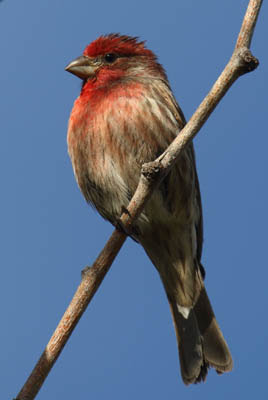 |
| House Finch. Greg Gillson. |
These birds are resident in towns throughout the United States, barely into southern Canada.
House Finches are year-round residents in southern Minnesota.
Both males and females are rather dusty brown, heavily streaked on the chest. Only the males have red feathers on forehead, breast, and rump.
House Finches love to eat black oil sunflower seeds in the shell. They like tube feeders best.
Setting up a winter bird feeding station in Minnesota
I would set up two different seed feeders for backyard birds in Minnesota.
The first feeder I would recommend is a tube feeder with black oil sunflower seeds (see articles below for specifics).
Tube feeders with black oil sunflower seeds will attract House Finches, American Goldfinches, Black-capped Chickadees, White-breasted Nuthatches, and Red-breasted Nuthatches.
The second seed feeder I would set up is a larger platform feeder with a big roof to keep out the snow.
Platform feeders will appeal more to Northern Cardinals and Dark-eyed Juncos and Blue Jays. The woodpeckers will feed on these platform feeders, too.
Set up a suet cage with suet blocks for the woodpeckers, nuthatches, and chickadees.
Because birds need liquid water to drink every day, I’d set up a bird bath with a heater to keep it ice-free.
Wrapping Up
Winter in Minnesota throws some serious punches, with frigid temperatures, biting winds, and snow-covered landscapes. But remarkably, birds don’t just endure this harsh season – they thrive in it! Here are some of the fascinating ways they survive the Minnesota winter:
Feathers: Their downy undercoats provide excellent insulation, trapping warm air close to their bodies. These feathers fluff up further in cold weather, creating a cozy barrier against the chill.
High Metabolism: Birds have incredibly fast metabolisms, burning food at a rapid rate to generate heat. They constantly replenish this fuel by foraging for food throughout the day, even in the harshest conditions.
Food Sources: While some insects disappear, birds adapt their diets. They may eat seeds, berries, nuts, and even scavenge leftover grains or fruits. Some species like chickadees store food in the fall, creating hidden caches to access throughout the winter.
Behavioral Adaptations: They huddle together to share body heat and conserve energy. Some species, like woodpeckers, utilize natural cavities or even excavate their own to seek shelter from the wind and snow.
Body Adjustments: During colder nights, birds lower their body temperature slightly in a state called torpor. This reduces their energy expenditure and helps them conserve precious resources.
Frequently Asked Questions
Do any birds stay in Minnesota in the winter?
Absolutely! Minnesota’s winters may be harsh, but many bird species have adapted to thrive in the cold and snow. The birds on my list above not only survive but thrive in Minnesota.
By adapting their diets, behavior, and even their physiology, these incredible creatures have found a way to thrive in one of the coldest states in the US. So next time you’re bundled up against the Minnesota winter, take a moment to appreciate the feathered friends who share your home and marvel at their remarkable resilience.
What is the best winter bird seed for Minnesota?
Choosing the best winter bird seed for Minnesota depends on several factors, including the types of birds you want to attract and the nutritional needs of different species. Here are some key considerations:
Seed Mixes:
- Black-oil sunflower seeds: A high-energy staple for many bird species, rich in fat and protein. Excellent choice for cardinals, jays, chickadees, nuthatches, and finches.
- Safflower seeds: Similar to sunflower seeds but with a harder shell, deterring squirrels and attracting birds with strong beaks like cardinals and grosbeaks.
- Millet: Tiny seeds perfect for finches and other small birds. Can be offered alone or mixed with larger seeds.
- Nyjer (thistle): A favorite among goldfinches and siskins, rich in oil and ideal for cold winter weather. Can be offered in feeders specifically designed for these smaller birds.
Additional Options:
- Suet: High-fat food source beneficial for woodpeckers, wrens, and chickadees. Can be offered in cakes or blocks and hung from feeders.
- Peanuts: Unshelled peanuts attract larger birds like jays and woodpeckers but can be messy and potentially harmful to some species. Shelled peanuts or peanut pieces are safer options.
- Corn (cracked or kernels): Attracts jays, crows, and some finches. Choose shelled or cracked corn to avoid waste and choking hazards.
Where do Robins go in the winter in Minnesota?
While many bird species stay put in Minnesota through the winter, American Robins are partial migrants, with some choosing to brave the cold and others heading south for warmer climes.
Those that stay shift their diet from worms and insects to berries, fruits, and even frozen fruits during winter. Places with abundant vegetation, like berry bushes and crab apple trees, offer them essential nourishment.
Something you may not know is that on particularly cold nights, they can enter a state of torpor, slightly lowering their body temperature to save energy.
Some robins only migrate relatively short distances, within the Midwest or to states like Missouri or Arkansas. Their southward journey takes them to regions with milder temperatures and more reliable food sources, allowing them to conserve energy and avoid the harshest winter conditions.
This means that you’re more likely to see robins in the southern part of the state, where winters are slightly milder and food sources are more abundant.
Related articles:
The most common backyard birds in Minnesota
Birds at your feeder in Minnesota
Red, Orange, & Yellow Birds in Minnesota
My recommended bird feeder setup






